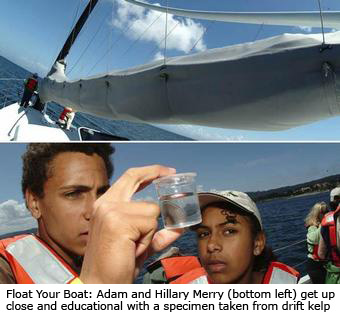 |
 |
||||||||
Deep Lessons To get onboard the 65-foot-long Derek M. Baylis, one has to duck beside the weathered wood pilings supporting the wharf. It’s late morning on an early-summer Friday as a small group of Monterey Bay Aquarium employees and volunteers, along with some of their children, file down the stairs under the pier to embark on a three-hour exploration of the bay. Through a year-old program known as Science Under Sail, the Aquarium runs these trips almost daily throughout the summer for kids ages 10 and up. Today’s trip is a preview day to get the staff familiar with the program.
Captain Jim “Homer” Holm explains that the 49-passenger sailing research vessel is a special design. Among its attributes: a racing-style keel, which gives the boat more stability; a high-tech rig with carbon-fiber masts, resulting in sails that flex in the wind; and booms that slant upward. (In practical terms, this means that unless people are checking out the view from the top of the cabin, which is discouraged, they aren’t going to get whopped on the head by the boom when the boat tacks.) But it’s still a sailboat, with not a lot of extra space, so people pass purses, backpacks, and extra jackets to be stowed inside the cabin, while naturalist Rolf Ridge outlines the agenda. “We will have the chance to do some actual science and also respond to whatever the bay presents,” he says. “There will be some spontaneity.” He explains that we might encounter whales or dolphins. He says that when we see fishing boats we will learn about their history. “We’ll look for animals and birds, and use the plankton net to pick up smaller animals and plants,” he reports. “We’ve got a computer screen to display those on. And we will be picking up a crab pot with bait. “We’ll spend the second half of the trip sailing. It will be a little more relaxed, you can zone out and ask questions and have fun.” The second captain, Dave Robinson, chimes in with some practical reminders, pointing out that the boat has fire extinguishers and automatically inflating rafts if the need should arise. He’s chipper as he talks about what could go wrong. “This is all about having fun,” he says. “But it’s not uncommon to be seasick.” He points out that the crew has “relief bands” for anyone who wants one—electronic devices worn on the wrist that help quell nasuea. “If you feel sick, a trick is to keep your eyes on the horizon, or take a turn steering the boat,” he says. “And if you do have to feed the fishes, remember, they live outside the boat.” . . . . . . . . . . . . . . . . . . . . . . . . . . . . . . . . . . . . . . . . . The whole crew—it seems—is relentlessly cheerful. They are overt in working in the Aquarium’s conservation ideals into all topics. It seems the boat could be a floating poster child for the whole organization. The passengers are asked what they are most hoping to see on the trip, and most list the big stars: whales, sharks, and dolphins. Simone Mortan, the Aquarium’s assistant manager of visitor programs, mentions that on a recent trip, the group found themselves in the midst of a pod of 500 or so dolphins leaping and breaching out of the water. Mortan later says that a video clip of the experience is currently playing outside the ticketing entrance to the Aquarium. But she emphasizes that it’s important not to focus on the charismatic marine mammals as the highlight of the trip. “We don’t want to set false expectations,” she says. “We rarely get far out enough to see whales.” But for now, a pass along Cannery Row down towards the Aquarium and Lovers Point is offering enough excitement to keep everyone interested. It’s not just what there is to see—like the rusting trawler bobbing in the harbor, the sea lions calling out in off-key harmony, the black cormorants diving for fish. It’s how it feels: the leaving behind of the shore, that itself feels good. There’s the wind picking up enough that people are going back to the cabin for their jackets, countered by the strong effects of the sun bouncing off the sea. And there’s the motion that (for the strong of stomach) feels just fine—good, really. There’s a sense of being rocked and of communicating with what’s below, unseen. Mortan later describes that communication as “an intangible quality.” “For some people, there’s a bit of fear of the ocean, and not necessarily knowing what’s going on in it,” she says. “Being on a sailboat makes an emotional connection to the sea: pulling kelp on board, pulling up a crab pot and having animals in it, is very exciting for people.” Mortan passes around a plastic tube that she says is filled with the contents of one dead Albatross stomach. Among the nasty items are at least four intact cigarette lighters, several ping pong balls, a fishing lure, a toothbrush, plugs and bottle caps. While the group checks it out, there is a call for volunteers to pull up some floating kelp. Adam Merry, 14, is on board with his sister Hillary, 12, and their mother, Teresa Merry, vice president of human resources at the Aquarium. Adam uses a boat hook to help grab a piece of brownish kelp and bring it on board. Genny Arredondo, a seasonal staff member at the Aquarium, is full of bubbling science enthusiasm but also keeps explanations simple enough for the non-scientists to understand. She and Mortan exclaim over the appearance of nudibranch eggs on the kelp leaves. “Nudibranchs [little sea slugs] are referred to as the ‘butterflies of the sea,’” Arredondo explains, opening up a reference book with photos. “They come in lots of different colors.” While the eggs are placed under a microscope and an image is projected on a laptop computer screen located in the cabin, Adam helps out with a “plankton tow.” A net with a collection bottle at the end is lowered into the water while Arredondo explains that just because plankton are tiny creatures, it doesn’t mean they will stay that way. “They say some plankton have bigger dreams,” she says. “They can turn into a sea star or a crab.” Mortan passes around a brushy piece of baleen from the mouth of a juvenile blue whale. “A blue whale has a heart as big as a car,” Arredondo says wide-eyed. “You could swim through its veins.” Meanwhile, the kids are helping pull up the plankton net, and its contents are dumped into a small aquarium. A fingernail-sized jellyfish appears in the tank. “We got a comb jelly!” Mortan says. “Way cool!” Morton explains that comb jellies use “sticky feathers” to catch other critters. “They have a fine web of tentacles that are spinning cartwheels to wipe across their mouth end to get food into the gut,” she says. Arredondo calls out that a water flea is being projected on the microscope, while the boat captains crack scientist jokes. The boat heads over to pick up a crab pot that has been placed in front of the Aquarium. It’s a neat reverse perspective to see the Aquarium from the water. In the distance are groups standing out on the decks looking at the boat, in front of them are scuba divers entering the kelp beds, and closest to the boat are tourists bobbing about in kayaks. Adam volunteers to pull up the crab pot. It is full of sea stars. A collective “ooh!” goes through the passengers; these babies are getting a better reception than the water fleas or comb jelly. The crew chimes in with sea star facts: “The gelatinous goo in the middle of its body is its stomach,” Arredondo says. “It turns its food into a liquid milkshake then slurps it up.” As the orange, purple and brownish speckled bat stars are passed around the boat, more facts are noted: “You can run a sea star through a meat grinder and turn it into new starfish,” Capt. Homer says, without a trace of unease. Then the wonders of the crab pot design are discussed. Mortan explains that the trap—baited with oily mackerel—is sized so that curious otters can’t get caught inside. She says that the California Department of Fish and Game has tested new versions of the traps with the Aquarium’s otters to prevent problems. The sea stars are put back in the pot and lowered into the water. “If they want to leave, they can get out through the round hole,” Mortan says. “We’ll let them out after the afternoon trip. But we’re not just going to fling them out like Frisbees into the water.” Capt. Homer gives some cannery trivia on how ships got their catch to shore, with a pulley then later a pump system. Then Capt. Robinson calls out, “Anyone feel like going sailing today?” The boat heels sharply to one side as the motor is killed and the sails are raised, and the mood onboard changes. Passengers talk less, there’s more of a sense of gripping to stay in place. One girl feels ill and is directed to lie down on top of the cabin. Some people sit on the onboard coolers, others go to the bow of the boat recline. But the science lessons continue. Arredondo passes out a lushly soft otter pelt. “They have a million hairs per square inch,” she says cheerfully. “We have 100,000 hairs on our whole head. No wonder they spend their days grooming.” . . . . . . . . . . . . . . . . . . . . . . . . . . . . . . . . . . . . . . . . . Mortan hands out some binoculars and talks about the Aquarium’s otter tagging program. And Capt. Homer gives some history about major ports in California’s history. Pelicans float over the waves as the boat heads some 3-4 miles north of Point Piños. A puffed rice bar is offered to the passengers by Ridge, and he emphasizes that it is organic and the importance of not dropping the wrapper overboard. “We want to stress that the ocean does not exist independently of the land,” he says. “Obviously, we associate organic [food] with a healthier bay.” Adam is steering the boat while his mother jokes that he is not even driving a car yet. And then, a dolphin is spotted and simultaneously a passenger’s hat flies overboard. The whole crew mobilizes into action. Capt. Robinson turns the boat around to get the hat, but the boat runs over it. It disappears, then slowly bobs up into view. “We almost sunk it! There it is!” people call out. After another turn, an Aquarium volunteer scoops the soggy baseball cap up with a net, while everyone cheers. It is the perfect incident for the crew to put its “leave no trace” ethic into action. As an added bonus, turning the boat around has provided a better glimpse of about four or five Rizzo’s dolphins. Many of the passengers venture onto the bow of the boat to check out the pale gray beauties. It is an odd position to be in, deeply reclining so as to avoid the possibility of connecting with the boom passing overhead, but not uncomfortable. As the dolphins recede from sight, Mortan holds a piece of hollow dolphin jawbone to people’s ears and scratches gently at one end to demonstrate how the sound travels. “They use echolocation to navigate,” she says. “The clicks they make bounce off their prey—the jaw magnifies the sound.” It’s a neat pairing of science lesson and real-life magic. Arguably more appealing than the comb jelly, at least to the non-scientists on board, the show of marine mammals in their real environment has been the piece de resistance of the trip. The boat ends its three-hour tour passing back into the harbor where the (mostly female) sea lions are draped over buoys like plump ladies sunning themselves. It’s just about the right time to come back to land—saturated with the motion of the sea and the nonstop science and history lessons. Mortan hopes that the saturation will result in a real change of attitude back on land. “The strength we have with the boat is that they will want to pay attention to the seafood watch card, maybe change some of the products they use in their garden. When you can touch people at an emotional level, you have a much greater chance of achieving that. Articles reprinted courtesy of Monterey
County Weekly |
Bad News for Local Women |
|||
 As orange life vests are passed out, the crew explains basic safety procedures— including tricks for avoiding mishaps with the head (the boat’s toilet)—while we slowly motor through the harbor.
As orange life vests are passed out, the crew explains basic safety procedures— including tricks for avoiding mishaps with the head (the boat’s toilet)—while we slowly motor through the harbor.